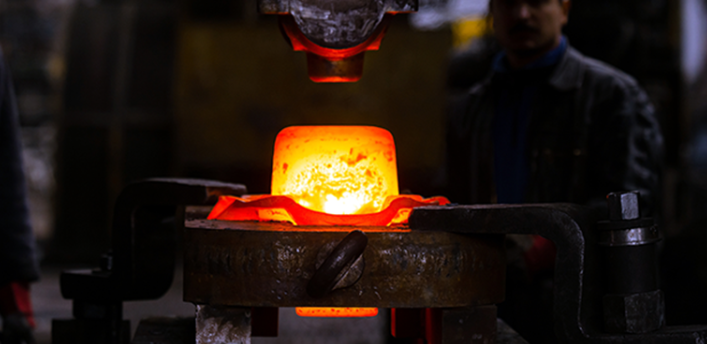3つの強力な方法:金属加工が超硬ボタンの未来を切り開く
炭化タングステン ボタンその卓越した硬度と耐摩耗性で知られる鍛造品は、鉱業や建設業から石油・ガス探査に至るまで、幅広い産業で欠かすことのできない部品です。しかし、製造工程、特に採用される鍛造方法が、これらの重要な部品の最終的な特性と性能に大きく影響することをご存知ですか?この包括的なガイドは、3つの著名な鍛造技術の複雑さを掘り下げています。 熱間鍛造、冷間鍛造、スウェージング -タングステンカーバイトボタンの微細構造、強度、全体的な品質が、それぞれの方法によってどのように形成されるかを明らかにする。
硬度を超えて:超硬ボタン製造において鍛造が重要な理由
成形の科学:鍛造の影響を理解する
- 微細構造の精密化: 制御された塑性変形を伴う鍛造工程は、炭化タングステンの結晶粒構造を微細化し、強度、靭性、耐摩耗性を向上させます。
- 密度と空隙率のコントロール: 鍛造により内部の空洞や気孔をなくし、より高密度で耐久性の高い超硬ボタンを製造することができ、過酷な使用条件にも耐えることができます。
- 形状の複雑さと精度: さまざまな鍛造技術は、複雑な形状や正確な寸法を達成するための柔軟性を提供し、特定のアプリケーションの要件に対応します。
細部を掘り下げる:熱間鍛造、冷間鍛造、スウェージングの説明
熱、圧力、そして精度:それぞれの方法を詳しく見る
1.熱間鍛造:
- プロセス 炭化タングステンのプリフォームを高温(通常は再結晶温度以上)に加熱してから、金型内で圧縮力を使って成形する。
- メリット
- 高温では材料強度が低下するため、鍛造力が低下する。
- 延性が強化され、より大きな形状変化や複雑な形状を可能にする。
- グレインフローと均一性が改善され、機械的特性が向上。
- 制限:
- 高温で酸化または脱炭の可能性があり、管理された雰囲気または保護コーティングが必要。
- 冷間鍛造に比べてエネルギー消費量が多い。
- 最終公差を達成するために、追加の機械加工工程が必要になる場合がある。

2.冷間鍛造:
- プロセス 室温またはわずかに上昇した温度で行われ、高い圧縮力を利用してダイス内でタングステンカーバイト・プリフォームを成形する。
- メリット
- 変形時の加工硬化による強度と硬度の向上。
- 優れた表面仕上げと寸法精度で、しばしば二次加工の必要性を低減または排除します。
- 熱間鍛造に比べてエネルギー消費が少ない。
- 制限:
- 低温での材料強度の増加により、より高い鍛造力が要求される。
- 成形性に限界があり、実現可能な形状の複雑さが制限される。
- 冷間加工中に誘発される内部応力を緩和するために、焼きなまし工程が必要になる場合がある。
3.スウェージング:
- プロセス タングステンカーバイドの棒または管を、回転する金型によって半径方向に圧縮し、直径を小さくする特殊な鍛造工程。
- メリット
- 特に円筒形や対称形状の場合、高い生産速度と効率を実現。
- 優れた表面仕上げと寸法管理。
- 長さ対直径比の高い細長い形状の作成に使用できる。
- 制限:
- 形状の柔軟性が低く、主に円筒形またはネットシェイプに近い部品に適している。
- 複雑な形状の場合、追加の加工工程が必要になることがある。
- 金型の設計とセットアップは、開放型鍛造に比べて複雑になる可能性がある。
特性を比較する:鍛造方法が超硬ボタン特性に与える影響
粒構造から表面仕上げまで:主な差別化要因
| 特徴 | 熱間鍛造ボタン | 冷間鍛造ボタン | スウェージボタン |
|---|---|---|---|
| 粒構造 | 再結晶による微細で均一な粒度 | 冷間加工による変形した細長い結晶粒 | 方向性を持った洗練された結晶粒構造 |
| 硬度(HV30) | 1400 – 1800 | 1600 – 2000 | 1500 – 1900 |
| 強さ | 高い靭性と耐衝撃性 | 非常に高い強度と耐摩耗性 | 強度と延性の優れた組み合わせ |
| 表面仕上げ | 良いが、二次加工が必要かもしれない | 優れた表面仕上げと寸法精度 | 表面仕上げは非常に良好で、表面欠陥は最小限に抑えられている。 |
| 形状の複雑さ | 高度に複雑な形状が可能 | シンプルな形状に限定 | 主に円筒形またはニアネットシェイプの部品に適しています。 |
| コスト | 中程度 | 高い | 低~中程度 |
業界を超えたアプリケーション:各ボタンタイプが得意とする分野
ドリルから摩耗部品まで:多様な使用例
- 鉱業と建設業 熱間鍛造カーバイドボタンは、ドリルビット、カッティングピック、その他の衝撃や摩耗の激しい工具に広く使用されています。
- 石油・ガス探査 超硬冷間鍛造ボタンは、極めて高い硬度と耐摩耗性が求められるダウンホールドリル工具に適しています。
- 金属加工と機械加工: スエージ加工された超硬ボタンは、高い寸法精度と滑らかな表面を必要とする摩耗部品、切削インサート、工具部品に使用されます。
TRUER: 精密鍛造のパートナー
業界の要求に応える:比較分析
| サプライヤー | 国名 | 価格帯(1個あたり) | 特産品 |
|---|---|---|---|
| TRUER | 中国 | $10 – $50+ | カスタム設計の鍛造ソリューション、高度な材料専門知識、迅速なプロトタイピング能力 |
| エレメント・シックス | 英国 | $15 – $60+ | 高性能カーバイド材種、要求の厳しい用途向けの特殊鍛造技術 |
| ケナメタル | アメリカ | $12 – $55+ | 幅広い標準およびカスタム鍛造ボタン、豊富な業界経験 |
| サンドビック・コロマント | スウェーデン | $14 – $70+ | 革新的な鍛造プロセス、持続可能性と性能の最適化に注力 |
注: 価格は概算であり、ボタンのサイズ、形状、等級、数量、その他の要因によって大きく異なる場合があります。
長所と短所を比較する:鍛造方法の比較考察
情報に基づいた決断を下す利点と限界
| 鍛造方法 | メリット | 制限事項 |
|---|---|---|
| ホットフォージング | - より低い鍛造力<br> - 強化された延性<br> - 穀物の流れの改善 | - 酸化の可能性<br> - エネルギー消費量の増加<br> - 二次加工が必要な場合がある |
| 冷間鍛造 | - 強度と硬度の向上<br> - 優れた表面仕上げ<br> - エネルギー消費の低減 | - より高い鍛造力<br> - 限られた成形性<br> - アニーリングが必要な場合がある |
| スウェージング | - 高い生産率<br> - 優れた寸法管理<br> - 細長い形状に適している | - 限られた形状の柔軟性<br> - 二次加工が必要な場合がある<br> - 複雑な工具 |
基本を超えて:鍛造の成果を左右する要因
ボタンのパフォーマンスの最適化:主な考慮事項
- 素材の特性: 炭化タングステン粉末の組成、粒度、初期特性は、その鍛造性と最終的なボタン特性に影響を与える。
- 鍛造パラメータ: 温度、圧力、ひずみ速度、および金型設計は、鍛造ボタンの微細構造、密度、および全体的な品質を決定する上で重要な役割を果たす。
- 熱処理: 焼きなましや応力除去などの鍛造後の熱処理は、超硬ボタンの機械的特性と寸法安定性をさらに調整することができる。
よくある質問鍛造に関するお問い合わせ
1.タングステンカーバイトボタンの用途に最適な鍛造方法は?
最適な鍛造方法は、希望するボタン形状、必要な機械的特性、生産量、コストなどの要因によって異なります。当社の技術専門家は、お客様の具体的なニーズに基づき、個別のガイダンスを提供することができます。
2.一貫したボタン品質を保証するために、鍛造工程で採用される主な品質管理手段は何ですか?
鍛造工程では、原材料の検査、鍛造パラメータの工程内監視、寸法チェック、硬度試験、微細構造解析など、厳格な品質管理措置が実施される。
3.TRUERは、特殊な表面処理やコーティングを施した鍛造超硬ボタンを提供できますか?
研磨、研削、コーティングなどの表面処理を施し、過酷な用途における鍛造ボタンの性能と寿命をさらに向上させます。
4.TRUERにカスタム鍛造タングステンカーバイドボタンを注文する場合の一般的なリードタイムはどのくらいですか?
カスタムオーダーのリードタイムは、デザインの複雑さ、採用する鍛造方法、必要数量、現在の生産能力などの要因によって異なります。個別の見積もりとリードタイムの見積もりについては、当社の営業チームにお問い合わせください。 これ.
5.TRUERは、炭化タングステン鍛造ボタンの設計と最適化に関する技術サポートやコンサルティングサービスを提供していますか?
経験豊富なエンジニアチームが、材料選定、設計の最適化、試作品の作成、トラブルシューティングなど、包括的な技術サポートを提供し、お客様の成功をお約束します。




